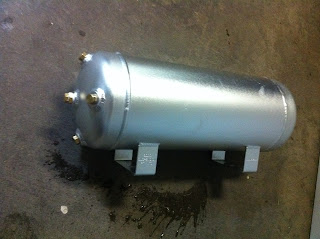I am happy with the engine as a first attempt but its heavier than I wanted (600 vs 400g) as I was conservative with wall thickness. I had designed for 3mm wall thickness but after spending hours working on it I was paranoid about cutting through the wall so I made it 5mm to be safe. The flange is also quite a bit thicker than I need it but I made it thicker so I could experiment with different clamping forces on the copper gasket. I allowed 1Kg for each engine in the vehicles design. Also I never seem to be able to get the bolt holes perfectly arrayed and there are always small mis-alignments (only goes together in one position).
I also made some parts to mount it to the test stand. This was a bit of a challenge because the inlet is on top of the injector plate as the thruster is designed to be bolted to a plate. I ended up making an adapter which makes the thruster all one size (size of the flange) so it can slide in a pipe which is fixed to the stand. There is then an inner free pipe which transfers force to the load cell. Both have slots milled in them at the load cell end at so the feed line can escape.
I really wanted to do a test later this week but Scott and Buren are not free until the weekend. After that I will start on a final revision. Hopefully we will get some good data this time.
I am starting to build up momentum on the hovering vehicle front. We completely redesigned the frame after the original concept proved tricky to build. The old design had a frame made from sections of right angle aluminium which formed a triangle with plates to make it more rigid.
The tank was epoxied to the brackets which I was never particularly keen on. The whole thing was pretty complex and I was worried that it wouldn't be rigid enough so we came up with a new design which is much simpler and will be allot easier to build.
The new tank is now held between two plates with three thin aluminium tubes which clamps the plates to the tank. Electronics are not shown but I would like to have a second plate bellow the lower one so the electronics box can go between it and the upper plate.
The thrusters are brought in really close which makes landing gear not particularly effective unless they are a long way out which would be heavy. For initial tests we want to have the vehicle hanging so I am not even bothering with landing legs at the moment. One idea is a foam disc as shown in black in the concept picture, however I think it would be likely to tip over when landing. I am worried that the tether will mess with the control system.
The vehicle will be initially pressurised to 500PSI leaving a safety factor of 1.9 which is much less than that of the nirous tank we were going to use. If the vehicle had a bad fall the tank could rupture which would be really really bad. I think we will need to find a place other than the workshop to test. Padding around tank might help but I still want to be comfortable that in the worst case know-one will be injured.
I started making the base plate yesterday and am fairly happy with how it turned out. It was pretty difficult to make as I had to plasma cut out the rough shape, mill it flat then linnish. I think I will try to find someone with a press brake for the rest. I would like to get a prototype frame mostly finished by the end of the weekend.
























